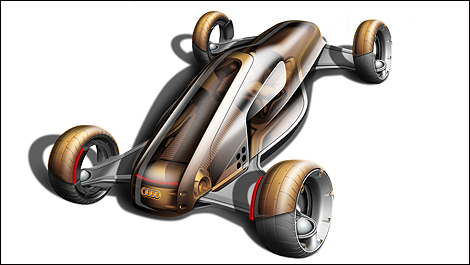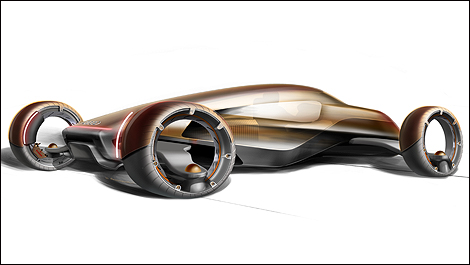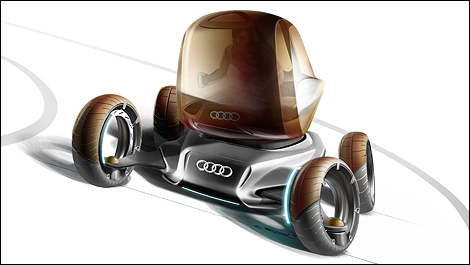Audi turns to social media for inspiration during 2009 LA Design Challenge
2009-1116
HERNDON, Va.,- Audi today released the final social media video installment documenting behind-the-scenes considerations that shaped its entries in this year’s Los Angeles Design Challenge, a competition associated with the upcoming L.A. Auto Show involving Southern California automotive studios.

eSpira
As part of the design process, the Audi design team leveraged social media as an interactive forum through which to solicit consumer insights. Using the Audi Facebook page as a central hub, the team was able to engage Audi fans – and regular Facebook users alike - in a variety of ways, including discussion threads, polls and feedback on photos and videos. This resulted in an active conversation between the Audi designers and the consumers they were targeting.
With its nearly 400,000 fans, the Audi Facebook audience is composed of passionate brand enthusiasts who have a mutual affinity for automobiles. They yielded feedback for the design team that proved uniquely thoughtful. Additionally, the broader Facebook community was welcome to participate as well, increasing the potential input. Collectively, Facebook participants played a key role in shaping the design and functionality of the Audi models submitted for the competition.
Case in point: the prevalence of communications tools in the final Audi designs. When engaging with Facebook users for input on the topic of connectivity, the Audi Design Team received overwhelming demand to stay in touch with users’ digital worlds – even behind the wheel. Taking this insight to heart, the design team developed a driving experience that, while solitary, enabled seamless communication through a host of channels including messaging and social networking integration via mobile broadband.
In fact, a large number of design elements in the final products can be credited to Facebook users.
“Often, we’d encounter decisions in which both options had merit from a design perspective,” said Jae Min, Chief Designer, Design Center, California. “In those instances, it was especially useful to field input from the Facebook users. After reviewing the feedback, we would eventually notice a consensus formed among the community which shaped our final designs.”

The theme of this year’s competition, titled “YouthMobile 2030,” asked design teams to envision automobiles appealing to young people of the future. Many major automakers participate in this annual competition that challenges their respective California design studios to push the limits of their expertise and imagination.

eOra
The Audi Design Team developed two complementary models meeting these criteria: the accessible Audi eOra and the aspirational Audi eSpira. Both cars function as extensions of one’s body and its senses. Using next generation vehicle control logic, they take even the smallest body movements and gestures of the driver into consideration to provide an unsurpassed command of the drive. The sportier eOra has a smaller footprint has unmatched agility.
Participating Facebook fans said having a stake in the design of these groundbreaking vehicles was empowering and rewarding. While engagement through social media is nothing new, transcending the virtual world to create something tangible is more novel for brands.
“It was really nice to see that Audi cared enough to listen, “ said Joe Zamani an active member of the Audi community on Facebook who participated in the regular Design Challenge queries on the page. “The fact that they felt our opinions were worth taking to heart was encouraging. It shows what a valuable resource social media can be when ideas are turned into something real.”
The Los Angeles Design Challenge results will be revealed on December 3, 2009 during the L.A. Auto Show.
The latest Audi web video captures the final stretch of the Los Angeles Design Challenge and the Audi design team’s creation process. Audi partnered with entertainment and marketing production agency Trailer Park to create the video.

eSpira
As part of the design process, the Audi design team leveraged social media as an interactive forum through which to solicit consumer insights. Using the Audi Facebook page as a central hub, the team was able to engage Audi fans – and regular Facebook users alike - in a variety of ways, including discussion threads, polls and feedback on photos and videos. This resulted in an active conversation between the Audi designers and the consumers they were targeting.
With its nearly 400,000 fans, the Audi Facebook audience is composed of passionate brand enthusiasts who have a mutual affinity for automobiles. They yielded feedback for the design team that proved uniquely thoughtful. Additionally, the broader Facebook community was welcome to participate as well, increasing the potential input. Collectively, Facebook participants played a key role in shaping the design and functionality of the Audi models submitted for the competition.
Case in point: the prevalence of communications tools in the final Audi designs. When engaging with Facebook users for input on the topic of connectivity, the Audi Design Team received overwhelming demand to stay in touch with users’ digital worlds – even behind the wheel. Taking this insight to heart, the design team developed a driving experience that, while solitary, enabled seamless communication through a host of channels including messaging and social networking integration via mobile broadband.
In fact, a large number of design elements in the final products can be credited to Facebook users.
“Often, we’d encounter decisions in which both options had merit from a design perspective,” said Jae Min, Chief Designer, Design Center, California. “In those instances, it was especially useful to field input from the Facebook users. After reviewing the feedback, we would eventually notice a consensus formed among the community which shaped our final designs.”

The theme of this year’s competition, titled “YouthMobile 2030,” asked design teams to envision automobiles appealing to young people of the future. Many major automakers participate in this annual competition that challenges their respective California design studios to push the limits of their expertise and imagination.

eOra
The Audi Design Team developed two complementary models meeting these criteria: the accessible Audi eOra and the aspirational Audi eSpira. Both cars function as extensions of one’s body and its senses. Using next generation vehicle control logic, they take even the smallest body movements and gestures of the driver into consideration to provide an unsurpassed command of the drive. The sportier eOra has a smaller footprint has unmatched agility.
Participating Facebook fans said having a stake in the design of these groundbreaking vehicles was empowering and rewarding. While engagement through social media is nothing new, transcending the virtual world to create something tangible is more novel for brands.
“It was really nice to see that Audi cared enough to listen, “ said Joe Zamani an active member of the Audi community on Facebook who participated in the regular Design Challenge queries on the page. “The fact that they felt our opinions were worth taking to heart was encouraging. It shows what a valuable resource social media can be when ideas are turned into something real.”
The Los Angeles Design Challenge results will be revealed on December 3, 2009 during the L.A. Auto Show.
The latest Audi web video captures the final stretch of the Los Angeles Design Challenge and the Audi design team’s creation process. Audi partnered with entertainment and marketing production agency Trailer Park to create the video.
Source: Audi/Auto123

Other news ::.

